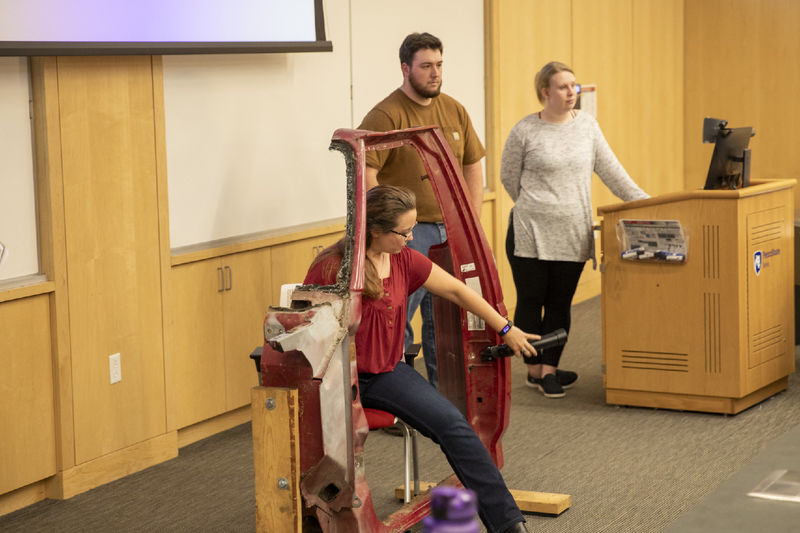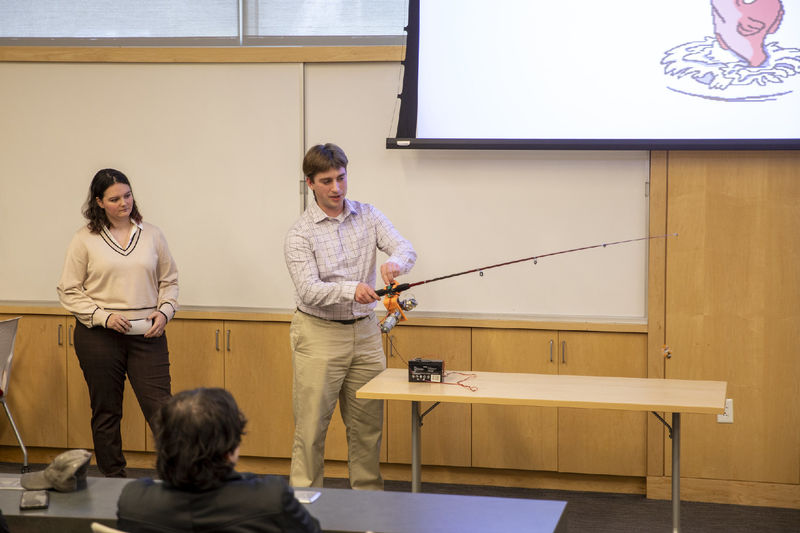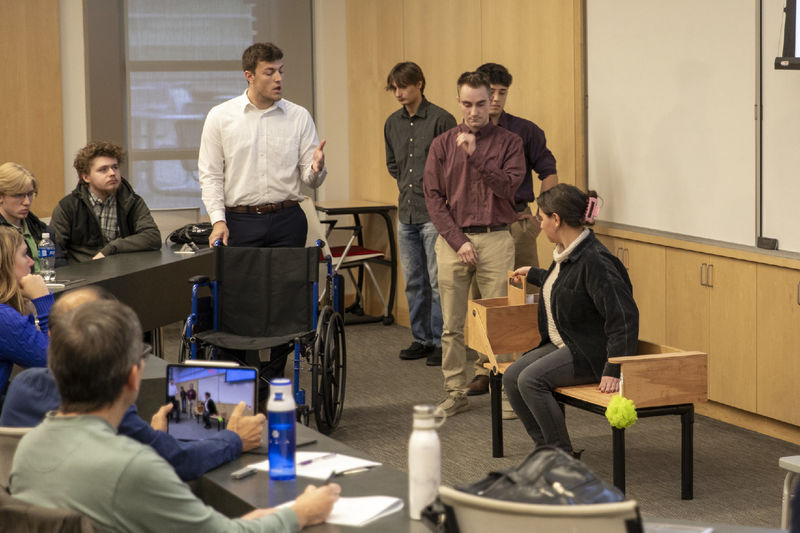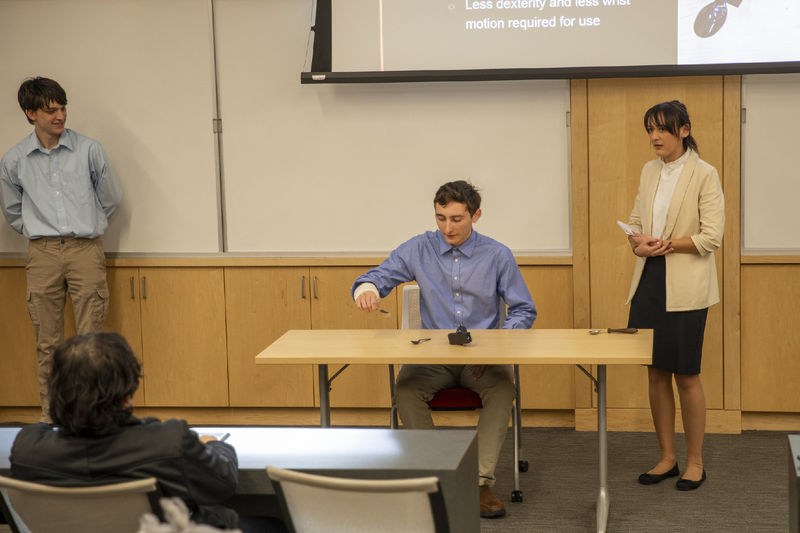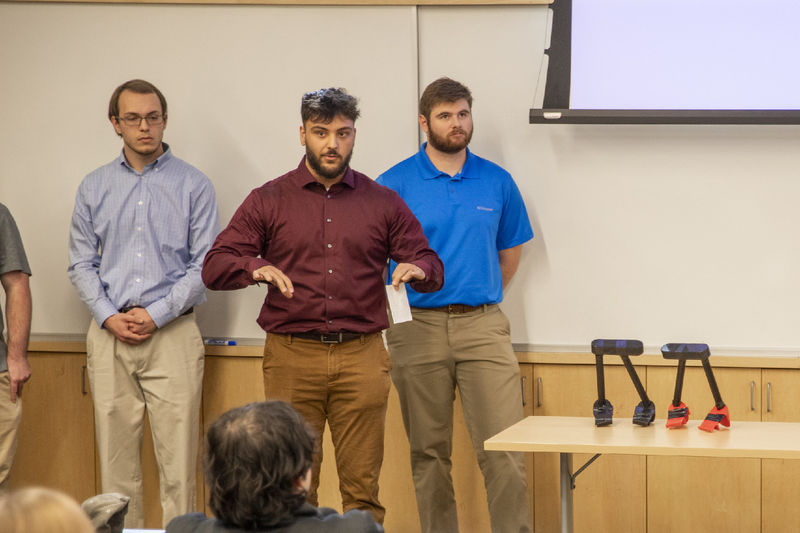
The Brown Team presented the Reel-y Adaptive Fishing Reel, which would allow any fishing rod to be modified to help individuals with manual dexterity difficulties.
WYOMISSING, Pa. — Students in the Penn State Berks mechanical engineering and occupational therapy programs have collaborated each year since 1995 to create devices to meet the needs of individuals with physical challenges as part of the Pfreimer Adaptive Equipment Project (PADEP).
This year, nine student teams collaborated to create equipment that meets the needs of individuals with physical disabilities. Each team was granted a $200 budget to purchase the materials necessary for their prototypes. The students presented their interdisciplinary projects at the end of the fall 2023 semester, which were then assessed by a panel of faculty members.
The Black Team presents an assistive car door handle
Team members: Kyle Haddock, Natalie Lawton, Bailey Levan, Kevin Ramirez, Autumn Steiner and Brynn Voshell
The Black Team created an assistive car door handle designed to help people with limited mobility to open and close car doors. In its pitch, the team cited more than 3 million wheelchair users in the United States who would benefit from their design. The assistive car door handle design is intended to be an attachment that fits to any car door frame. It then latches in place, assisting users who struggle sitting from a standing position or vice versa. The student team created its prototype using found materials as well as 3D-printed ones and estimated the production cost to be just under $13 and that mass production of the device could decrease manufacturing costs.
The Brown Team presents the Reel-y Adaptive Fishing Reel
Team members: Dale Belville, Ainsley Butler, Maddy Hawley, Nolan Kratz, Seth Williams and Lauren Wright
The Brown Team presented the Reel-y Adaptive Fishing Reel, which would allow any fishing rod to be modified to help individuals with manual dexterity difficulties. The team shared that the product would be ideal to help people with physical weaknesses, such as stroke and multiple sclerosis, the geriatric community, and those who need to conserve energy due to chronic conditions.
The Red Team presents portable assistive toilet handrails
Team members: Broderick Bolyn, Anthony Carpenter, Jonathan Haraschak, Isaiah Johri, Tatiana Martin, Lucas Smith and Skylar Zaleski
The Red Team’s portable assistive toilet handles are a universal tool that can attach to any toilet bowl, offering added stability to people with limited strength in their lower extremities as they transition from standing to sitting position. The team's portable assistive handrails boast a universal fit, and their size lends easily to portability. The device is also easy to clean and inexpensive to produce, unlike competing products. The team estimates that the device would be inexpensive to manufacture.
The Orange Team presents the Universal Angled Handle
Team members: Kathryn Kundrat, Ariella McNally, Joseph Pasterski, Braden Ritter, Zachary Schlegel and Nathan Vreeland
The Orange Team designed a Universal Angled Handle, which helps users grip utensils and acts as an assistive device ideal for individuals with arthritis or wrist injuries. In their presentation, team members shared that the Universal Angled Handle features a built-up angled handle with a comfortable grip that allows users to keep a neutral wrist position, requiring less dexterity and less wrist motion than a regular utensil.
The Yellow Team presents Button Buddy
Team members: Kalea Belville, Megan Goodhart, Kayln Hess, Sabiha Kermalli, Mason Lazarony and Mikayla Ramsey
The Yellow Team proposed the Button Buddy, a utilitarian product that fits well within the rise of the global adaptive clothing market. The Button Buddy is designed with geriatrics in mind and other individuals with decreased motor control and functioning in their hands and fingers. One end features a loop that helps users secure buttons, and the other end features a hook that helps users move the zippers up and down.
The Green Team presents Buddy Bench
Team members: Jacob Christman, Alexander Rivera, Kohlby Rollman, Nicholas Rutkowski, Aysia Weiler and Alexa Zimmerman
The Green Team designed its device to make showering easier and safer for the elderly and those with limited mobility. People who have suffered from stroke, balance issues, weakness in their lower extremities, and aging will benefit from this product as it not only allows them to stay seated while bathing but also brings all their shower supplies closer with help from its rotating flexible caddy location.
The Blue Team presents the Advanced Handled Applicator (AHA)
Team members: Rebecca Bross, Alexander Hackett, Amandre Hatcher, Danny Kha, Lela Lamp and Connor Thompson
In its presentation, the Blue Team shared its Adaptive Handled Applicator, or AHA, perfect for makeup artists and makeup wearers with limited manual ability. Users put their makeup tool into the holder, twist the knob to tighten the device’s grip on the makeup tool, and then apply their makeup. Because the device has a wide grip, users with arthritis and other manual dexterity problems can use the device more easily than a typical makeup applicator.
The Violet Team presents LidVantage
Team members: Morgan Barnes, John Brady, Mason Layton, Shiv Patel, Andrei Pavel, and Mary Reichley
The Violet Team presented LidVantage, a button-activated and machine-automated toilet lid that allows users to lift and lower their toilet seat and lid at their convenience. The device is unique in that most automatic toilet seats require applied pressure to a pedal or a sensor to open and close.
The Gray Team presents an automatic toothpaste dispenser
Team members: Madison Anslow, Alexander Contros, Miral Ibrahim, Shannon McLaughlin, Kathrynn Weller, and Scott Ziegler
The Gray Team presented an automatic toothpaste dispenser. The device is intended to help individuals with disabilities and conditions, such as arthritis, make the act of squeezing toothpaste out of its tube less difficult and painful. With a sensor that triggers when to dispense the toothpaste, users do not have to put a strain on their wrists to apply toothpaste to their toothbrush.
Innovating for the future
The Black, Orange and Yellow Teams were selected to move forward with their prototypes in spring 2024. In the spring 2024 semester, the chosen teams will refine their prototypes while business students develop business plans for the devices.
For more than 15 years, Penn State Berks students have proposed countless ideas for devices to support individuals with a wide spectrum of abilities. To learn more about the Pfreimer Adaptive Equipment Project and its history, contact Rungun Nathan at rungun.nathan@psu.edu.
Dr. Rungun Nathan
Dr. Rungun Nathan is a Associate Professor of Engineering, Program Coordinator of Mechanical Engineering at Penn State Berks


